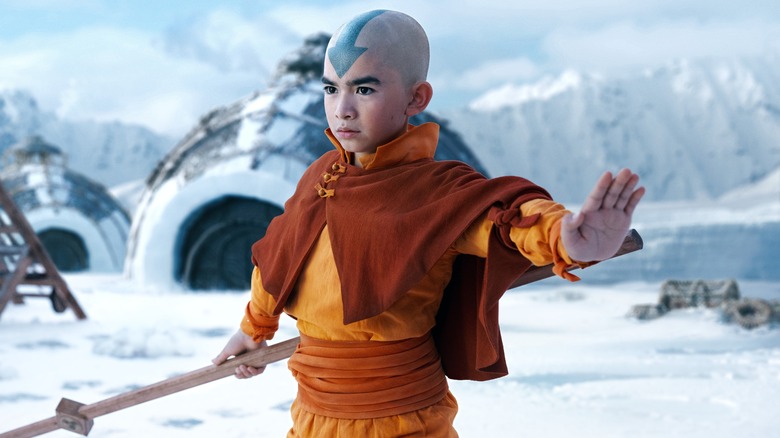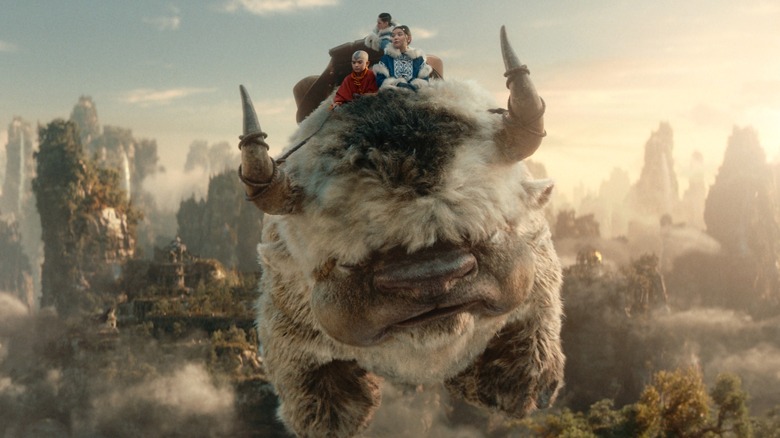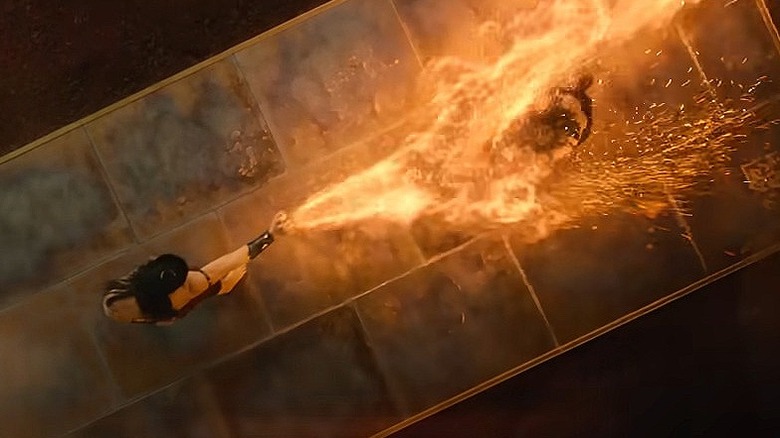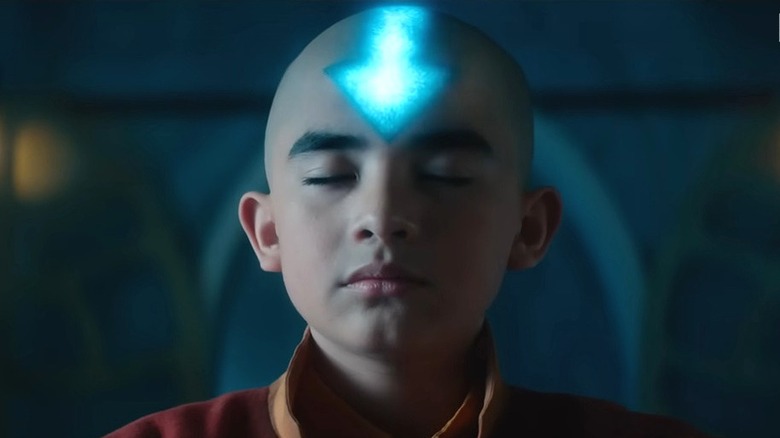Avatar: The Last Airbender - Every Power Shown In Netflix's Trailer Explained
In early November 2023, Netflix finally debuted footage from its upcoming live-action adaptation of "Avatar: The Last Airbender," set to release in 2024. It's been a long time coming, as the project began development in 2018. The years between have seen more than their fair share of controversy, with original creators Michael Dante DiMartino and Bryan Konietzko departing over the artistic direction Netflix wanted to pursue (not to mention fan backlash over several casting decisions).
Despite everything, the teaser trailer looks good. Great, even! The costumes and set pieces are stunning, the color palette matches the cartoon's vibrancy, and what it shows of the bending proves that Netflix learned from M. Night Shyamalan's disastrous mistakes. Seriously, the teaser trailer is so packed with benders that it almost feels like Netflix deliberately set out to separate itself from the previous live-action debacle, which faltered on its depiction of elemental magic.
While there's no waterbending in "The Last Airbender" teaser trailer, there is a little earthbending, even more airbending, and a veritable feast of firebending to enjoy. Plus, Netflix throws in a sneak peek at Aang (Gordon Cormier) slipping into the Avatar State. The footage isn't just combat bending, either. Yes, the firebending is pretty violent, but the airbending and the earthbending strike a balance between action and function, which proves that the streaming studio understands on some level how deeply integrated bending is within the four nations' cultures.
Omashu runs on earthbending
Netflix's "Avatar: The Last Airbender" teaser trailer provides a long, panning shot of Omashu, the second largest city in the Earth Kingdom, which is itself the largest of the four nations. We know that the footage depicts Omashu because of the city's iconic design — sturdy walls surrounding a conical mountain, draped in stone towers and rocky chutes — that is unreplicated anywhere else in the world of "The Last Airbender." The camera isn't close enough to make out any individual earthbenders doing their earthbending thing, but the screen is full of proof that this is happening nonetheless, because Omashu runs on earthbending. The mighty gate slides open or presses shut by the will of earthbenders, and the chutes use gravity to deliver items downward but require earthbending to deliver items in reverse.
The teaser trailer shows the gates of Omashu opening, so we know that somewhere nearby is an earthbender, or a team of earthbenders, using their skills. If you look closely, there's a single figure standing at the bottom of the screen when the shot begins. While that might be the earthbender in charge of the gates, it looks more like Aang's "Bonzu Pippinpaddleopsicopolis III" disguise from Season 1, Episode 5, "The King of Omashu." Not to beat a dead horse, but this singular instance of earthbending is already the most impressive live-action display of the ability to exist.
Aang and Appa soar through the skies (and kick Fire Nation butt)
Aside from Zaheer (Henry Rollins) in "Avatar: The Legend of Korra," most airbenders cannot fly. Much like Buzz Lightyear, they've mastered the art of falling with style, which is why Aang carries his glider staff. He bends the winds against the fabric to propel himself through the skies like a tiny, human-shaped boat. Netflix's "Avatar: The Last Airbender" teaser trailer shows both Aang and Appa using their airbending abilities to produce this near-flight effect. These snippets are used to showcase sweeping landscape shots, but they also allow fans to appreciate a dedication to faithfully recreated details, like the shape of Crescent Island, where the Fire Sages tend to the Fire Temple.
There's also footage of the devastation that airbending can wreak in a shot that appears to be of Prince Zuko (Dallas Liu) and his Fire Nation soldiers during their invasion of Kyoshi Island. We use the term "appears" here because the screen is almost immediately obscured by a mass of flying bodies as Aang hurtles to the earth, surrounded by a violent gust. No one seems to be lethally injured ... but no one is left standing, either. It's funny because Aang is technically a pacifist. He seeks non-violent solutions wherever possible. Still, both the original animated series and Netflix's live-action adaptation showcase what the little guy can do when he's good and peeved.
Everything changed when the Fire Nation attacked
Netflix's "Avatar: The Last Airbender" teaser trailer focuses the lion's share of its footage on the all-consuming power of the Fire Nation. The opening shot features Sozin's Comet, a space rock that approaches once every 100 years and bestows a frankly unfair stat boost to every firebender bathed in its burning light. Shortly after that, there's a shot that seems to showcase a group of firebenders using their abilities for short-term flight. In the original cartoon, Princess Azula (Gray DeLisle) does something similar in Season 3, Episode 16, "The Southern Raiders."
Firelord Ozai (Daniel Dae Kim) is seen blasting a hellish stream of fire at a young Prince Zuko for speaking out of turn during a war council. Tragically, it looks like Zuko attempts to protect himself from his father's onslaught in Netflix's version of the scene. The outcome remains unchanged, but it's hard not to feel worse for the kid knowing that his father willingly pushed through his defense to scar him as punishment.
Netflix's teaser trailer also features a taste of Zuko's battle talents. The four different styles of bending are notably inspired by four different styles of martial arts (waterbending is Tai Chi, earthbending is Hung Gar, airbending is Baguazhang, and firebending is Northern Shaolin), and the footage of Zuko's firebending is the first to really hammer this connection home.
The Avatar State gets stronger with each reincarnation
Fans of "Avatar: The Last Airbender" know that whenever Aang's tattoos start to glow, a brutal fight is sure to follow. That's because the glowing, which Netflix showcases for the briefest glimpse in its teaser trailer, means that Aang is slipping into the Avatar State. Call it Super Saiyan, or Ultra Instinct, or even Gear 5, they're all functionally the same. The Avatar State is a spiritually charged transformation that allows the current Avatar to simultaneously wield the combined might and knowledge of all past incarnations.
It's a lot for a lone 12-year-old kid to handle. Imagine going through puberty with the power of a god and a few hundred opinionated voices screaming inside your skull, and you've got a decent grasp of the situation. He struggles to control the State, which more often than not controls him. A fun fact about airbending avatars is that their tattoos glow along with their eyes during the Avatar State because the tattoos are placed along the chi lines of the body, which means that the few smart folks that antagonize Aang have a more than clear warning sign when they need to hightail it out of dodge.
The footage seen in Netflix's teaser trailer doesn't appear to depict an out-of-control Aang, however. He seems calm and collected, which is actually worse for his opponents because when Aang is resigned to damage, then nothing is about to get in his way.
Netflix's live-action "Avatar: The Last Airbender" will be available to stream on February 22, 2024.



